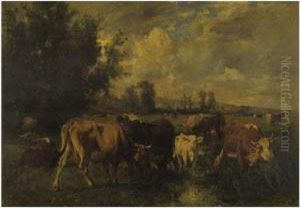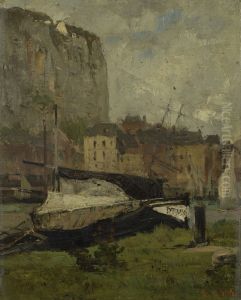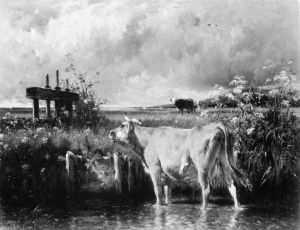Emile Van Marcke Paintings
Émile van Marcke was a French painter born on August 30, 1827, in Sèvres, a commune known for its porcelain manufacture near Paris, France. He is particularly recognized for his pastoral landscapes and his realistic depictions of cattle, following in the tradition of the animaliers, a group of artists specialized in the realistic portrayal of animals. Van Marcke was influenced by the rural naturalism of the Barbizon School and was a contemporary of artists such as Jean-François Millet and Théodore Rousseau, who also focused on naturalistic and bucolic subjects.
Van Marcke received training in art at an early age and developed his skills under the tutelage of the esteemed animal painter Troyon, who was a significant influence on his style and subject matter. His connection with Troyon was not only as a student but also at a professional level; he worked at the Sèvres Porcelain Factory, where he decorated porcelain with his mentor.
Throughout his career, van Marcke exhibited at the prestigious Paris Salon, where his work was well received. He became known for his ability to capture the essence of the animals he painted, imbuing them with a sense of character and serenity. His landscapes often depicted the lush, fertile pastures of the French countryside, and he had a particular talent for rendering the effects of light on the natural environment.
Van Marcke's paintings were admired for their rich, textural quality and the lifelike presence of the cattle that often featured in his work. He was skilled at capturing the various moods of nature and the different times of day, from the misty mornings to the golden light of dusk.
Émile van Marcke achieved success not only in France but also abroad, as his works were sought after by collectors in Europe and the United States. Despite this success, he lived a relatively quiet life dedicated to his art, away from the bustling art scene of Paris. He passed away on February 10, 1890, in Hyères, in the south of France. His legacy is preserved in the paintings that continue to be admired for their pastoral beauty and tranquil depictions of agricultural life.


